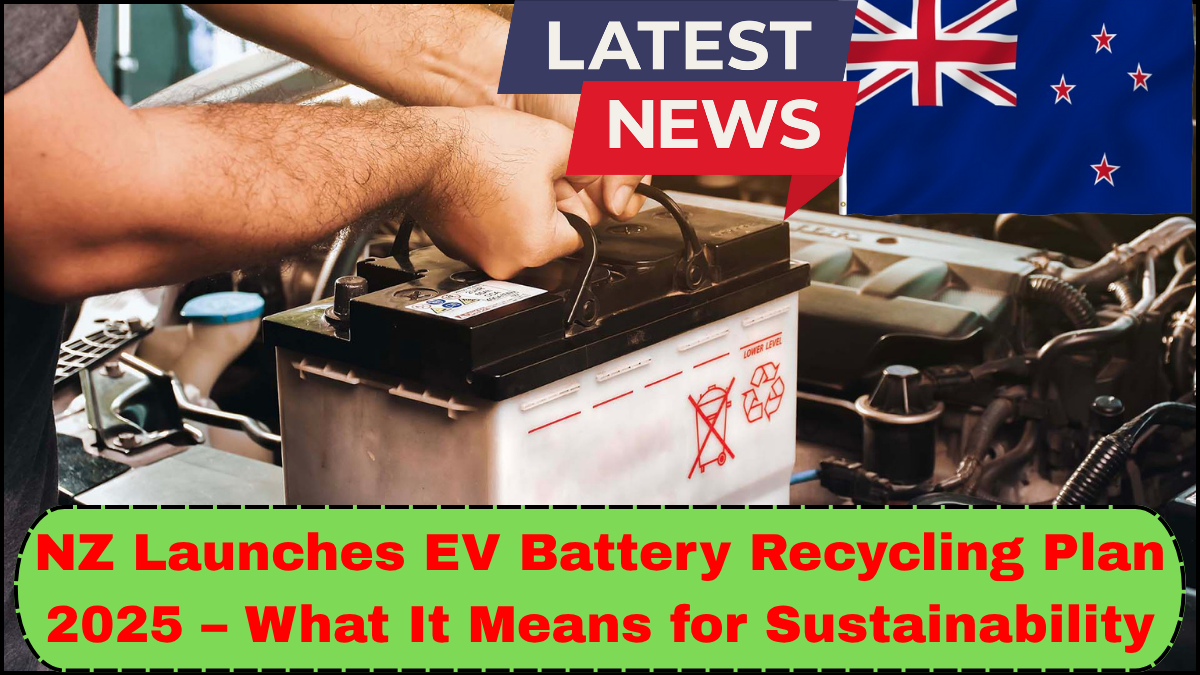New Zealand is taking a major step forward in environmental responsibility with the launch of its EV Battery Recycling Plan 2025. As electric vehicle (EV) usage grows, so does the need to manage the lifecycle of their batteries responsibly. This new initiative marks a significant milestone in the country’s push towards a cleaner, greener future by addressing a pressing challenge: what to do with end-of-life EV batteries.

Why EV Battery Recycling in NZ Matters
The surge in electric vehicle adoption is a win for reducing tailpipe emissions, but EV batteries eventually degrade and reach a point where they can no longer efficiently power vehicles. Without a structured recycling system, these batteries pose environmental and safety risks due to toxic materials like lithium, cobalt, and nickel.
By introducing a national framework for EV Battery Recycling in NZ, the government aims to prevent these batteries from ending up in landfills and instead recover valuable raw materials for reuse. This not only supports the circular economy but also reduces the need for new resource extraction, a process often linked to significant ecological damage.
Key Components of the 2025 EV Battery Recycling Plan
- National Collection Network A centralized infrastructure will be developed to collect used EV batteries from across the country. This ensures consistent handling and tracking from the point of disposal to final recycling.
- Certified Recycling Facilities Approved and regulated recycling centers will be equipped to safely dismantle, sort, and process battery components. These facilities will use cutting-edge technology to extract precious materials while minimizing emissions and waste.
- Second-Life Applications Not all retired batteries are completely unusable. Many retain enough capacity to serve other purposes. The plan includes provisions to repurpose these batteries in second-life EV applications, such as energy storage for homes or commercial use, reducing overall environmental impact.
- Producer Responsibility Scheme The plan will enforce an Extended Producer Responsibility (EPR) model. Manufacturers and importers will be required to fund and facilitate the recycling of their products, encouraging eco-friendly battery design from the outset.
How This Plan Supports Sustainability
New Zealand’s EV Battery Recycling Plan directly contributes to its national sustainability goals. By closing the loop on battery usage, the country is reducing waste, conserving natural resources, and lowering carbon emissions linked to mining and battery production.
The reuse of materials means fewer virgin resources need to be mined, protecting ecosystems and cutting energy consumption. Additionally, the second-life EV market can generate new economic opportunities, such as job creation in refurbishing and repurposing industries.
Global Context: How NZ Compares
Countries like Germany, Japan, and the U.S. have already launched similar programs. What sets New Zealand apart is its focus on integrating indigenous perspectives and community-led innovation into the recycling process. For instance, some pilot projects involve iwi (Māori tribes) in the governance and operation of recycling centers, ensuring that sustainability efforts are inclusive and culturally aligned.
Challenges Ahead
Despite its strong foundation, the EV Battery Recycling Plan 2025 faces challenges:
- Scalability: As EV sales rise, the volume of used batteries will increase dramatically.
- Technology Costs: Advanced recycling equipment is expensive to install and maintain.
- Public Awareness: Consumers must understand how and where to dispose of their batteries.
However, with continued investment and community engagement, these hurdles are manageable. Government support combined with private sector innovation will be key.
Conclusion
The EV Battery Recycling in NZ initiative is more than a policy move; it’s a shift toward a sustainable future. By responsibly managing battery waste and unlocking the potential of second-life applications, New Zealand is setting a benchmark for clean-tech stewardship. This plan not only addresses today’s waste but also builds the foundation for a more sustainable, circular economy in the long term.
FAQs
Q1: What types of EV batteries are covered in the recycling plan?
All lithium-ion batteries used in electric vehicles, including passenger cars, buses, and light commercial vehicles, will be included.
Q2: How can individuals dispose of their EV batteries?
Consumers will be able to return batteries to designated collection centers. Details on locations and procedures will be available on a dedicated government portal.
Q3: What happens to batteries after collection?
Batteries are assessed for either second-life use or recycling. Viable batteries are repurposed; others are dismantled to recover materials like lithium and cobalt.
Q4: Will this initiative affect the price of EVs?
Initially, manufacturers may pass on some recycling costs to consumers, but economies of scale and efficiency improvements should stabilize prices over time.
Q5: When does the plan officially take effect?
The EV Battery Recycling Plan is set to be fully operational by mid-2025, with phased rollouts beginning earlier in the year.
click here to learn more